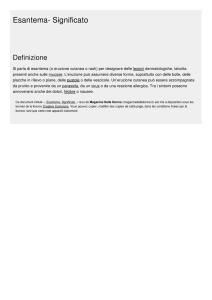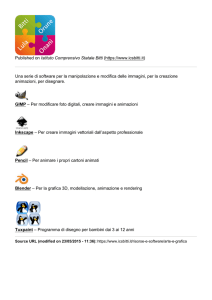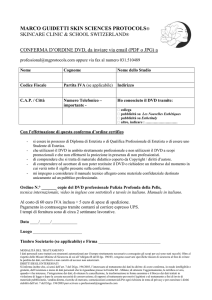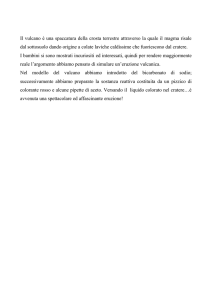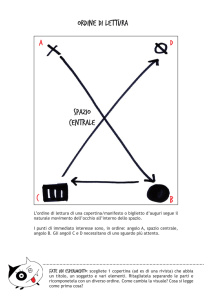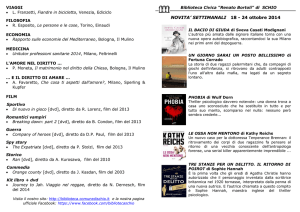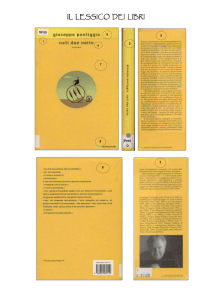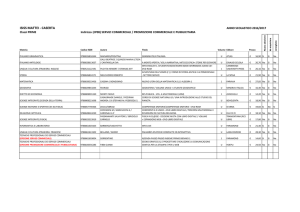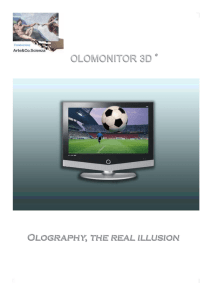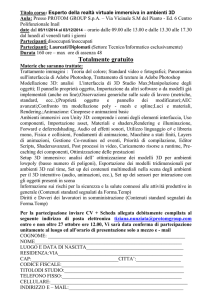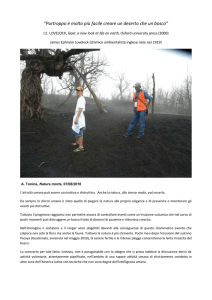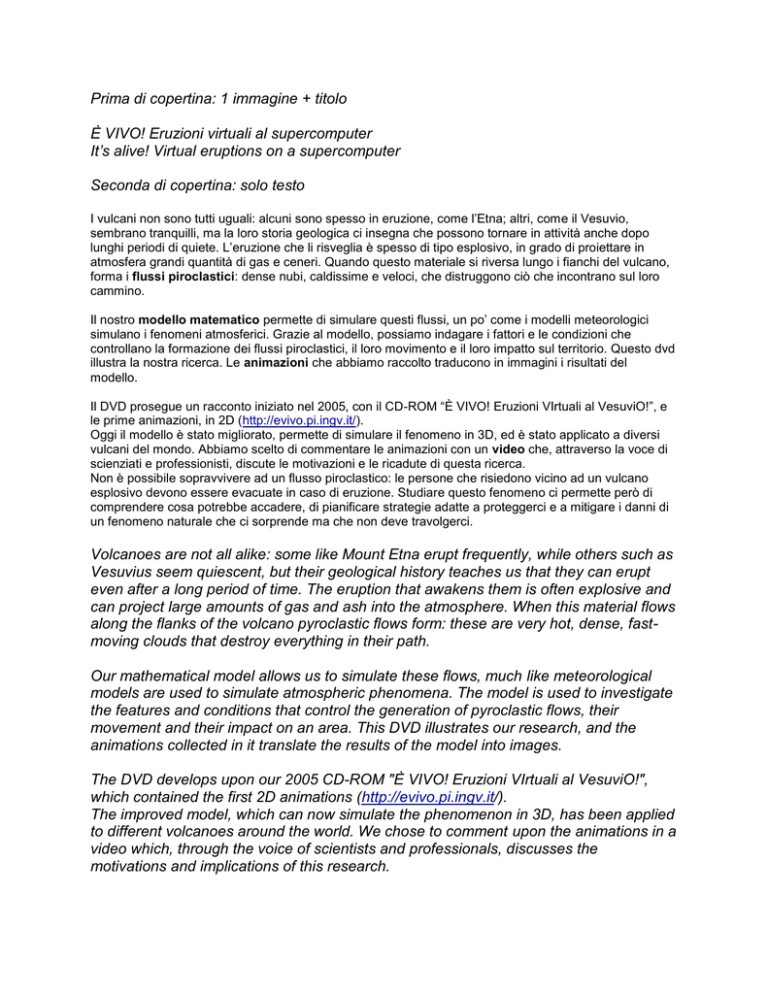
Prima di copertina: 1 immagine + titolo
È VIVO! Eruzioni virtuali al supercomputer
It’s alive! Virtual eruptions on a supercomputer
Seconda di copertina: solo testo
I vulcani non sono tutti uguali: alcuni sono spesso in eruzione, come l’Etna; altri, come il Vesuvio,
sembrano tranquilli, ma la loro storia geologica ci insegna che possono tornare in attività anche dopo
lunghi periodi di quiete. L’eruzione che li risveglia è spesso di tipo esplosivo, in grado di proiettare in
atmosfera grandi quantità di gas e ceneri. Quando questo materiale si riversa lungo i fianchi del vulcano,
forma i flussi piroclastici: dense nubi, caldissime e veloci, che distruggono ciò che incontrano sul loro
cammino.
Il nostro modello matematico permette di simulare questi flussi, un po’ come i modelli meteorologici
simulano i fenomeni atmosferici. Grazie al modello, possiamo indagare i fattori e le condizioni che
controllano la formazione dei flussi piroclastici, il loro movimento e il loro impatto sul territorio. Questo dvd
illustra la nostra ricerca. Le animazioni che abbiamo raccolto traducono in immagini i risultati del
modello.
Il DVD prosegue un racconto iniziato nel 2005, con il CD-ROM “È VIVO! Eruzioni VIrtuali al VesuviO!”, e
le prime animazioni, in 2D (http://evivo.pi.ingv.it/).
Oggi il modello è stato migliorato, permette di simulare il fenomeno in 3D, ed è stato applicato a diversi
vulcani del mondo. Abbiamo scelto di commentare le animazioni con un video che, attraverso la voce di
scienziati e professionisti, discute le motivazioni e le ricadute di questa ricerca.
Non è possibile sopravvivere ad un flusso piroclastico: le persone che risiedono vicino ad un vulcano
esplosivo devono essere evacuate in caso di eruzione. Studiare questo fenomeno ci permette però di
comprendere cosa potrebbe accadere, di pianificare strategie adatte a proteggerci e a mitigare i danni di
un fenomeno naturale che ci sorprende ma che non deve travolgerci.
Volcanoes are not all alike: some like Mount Etna erupt frequently, while others such as
Vesuvius seem quiescent, but their geological history teaches us that they can erupt
even after a long period of time. The eruption that awakens them is often explosive and
can project large amounts of gas and ash into the atmosphere. When this material flows
along the flanks of the volcano pyroclastic flows form: these are very hot, dense, fastmoving clouds that destroy everything in their path.
Our mathematical model allows us to simulate these flows, much like meteorological
models are used to simulate atmospheric phenomena. The model is used to investigate
the features and conditions that control the generation of pyroclastic flows, their
movement and their impact on an area. This DVD illustrates our research, and the
animations collected in it translate the results of the model into images.
The DVD develops upon our 2005 CD-ROM "È VIVO! Eruzioni VIrtuali al VesuviO!",
which contained the first 2D animations (http://evivo.pi.ingv.it/).
The improved model, which can now simulate the phenomenon in 3D, has been applied
to different volcanoes around the world. We chose to comment upon the animations in a
video which, through the voice of scientists and professionals, discusses the
motivations and implications of this research.
You cannot survive a pyroclastic flow: people living near an explosive volcano must be
evacuated in case of eruption. The study of this phenomenon allows us to understand
what might happen, to plan appropriate strategies to protect ourselves and to mitigate
the damage of a natural phenomenon that may surprise but should not overwhelm us.
Terza di copertina: 3 immagini (una con didascalia che ti devo mandare!)
Quarta di copertina: 4 figure + testo
Un modello matematico descrive le dense nubi di gas e ceneri che scorrono lungo i
fianchi del vulcano durante un’eruzione esplosiva. I risultati del calcolo sono tradotti in
immagini e compongono le animazioni inserite in questo DVD. Il modello, applicato a
diversi vulcani in Italia e nel mondo, considera le caratteristiche di ciascun vulcano e
dell’eruzione che si vuole rappresentare.
Il breve video che accompagna le animazioni raccoglie le voci di chi, a vario titolo,
lavora sui vulcani, e racconta come e perché questo modello teorico ci può aiutare a
comprendere meglio il fenomeno naturale e a capire come proteggerci da esso.
A sophisticated mathematical model describes the clouds of gas and ashes that flow
down the flanks of the volcano during an explosive eruption. Results have been
translated into the images that compose the animations included in this DVD. The
model, applied to different volcanoes in Italy and worldwide, incorporates the
characteristics of each volcano and of the eruption considered.
The short video that accompanies the animations gathers the voices of those who study
volcanoes, and tells how and why this theoretical model can help us better understand
the natural phenomenon and how to protect ourselves.
Info: [email protected], [email protected]
(non so se questo sia meglio metterlo in 2a o in 4a di copertina)

